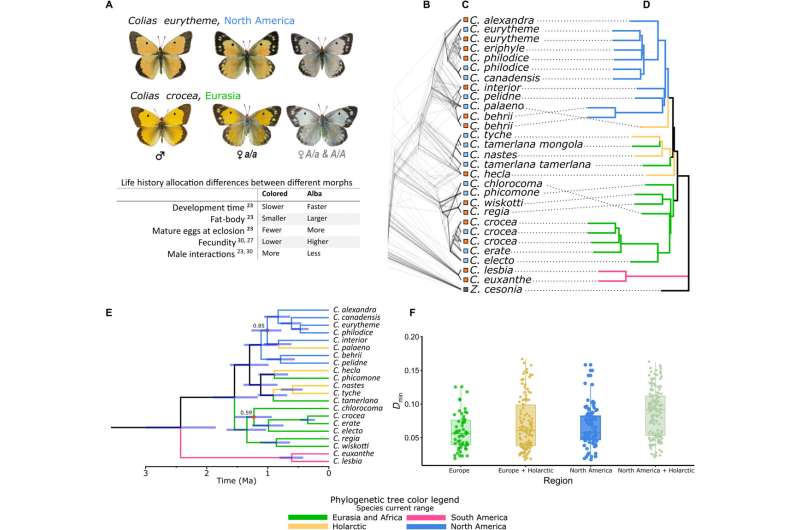This article has been reviewed according to Science X's editorial process and policies. Editors have highlighted the following attributes while ensuring the content's credibility:
fact-checked
peer-reviewed publication
trusted source
proofread
Biologists report on alternative life-history strategy in Colias butterflies

Have you ever marveled at the vast diversity of life on our planet, from tiny creatures living only a few hours to majestic beings that can survive for centuries? These differences in lifespan, size, and reproductive age are known as life-history strategies, and they have evolved over time as organisms adapt to their environments.
Evolutionary biologists have long been interested in understanding the factors that contribute to the evolution and maintenance of multiple alternative life-history strategies (ALHS) within species that lead to adaptation and novel traits. A new study published in Science Advances has not only revealed that an ALHS in Colias butterflies has an ancient origin, but also determined the mechanisms contributing to its persistence over millions of generations.
Colias butterflies are a charismatic group of butterflies found on almost all continents, and are characterized by their brightly colored orange or yellow wings in both males and females. However, in about one-third of the 90 Colias species, a portion of females instead have white colored wings called Alba morphs. This change in color appears to be a tradeoff in how females invest energy reserves gathered when in the caterpillar stage.
During the transition into butterflies, females either spend these reserves to make orange wings and become very attractive to males, or they make no color (Alba) and use these resources to have more offspring. Thus, Alba is not just a simple color variant, but a visual representation of an ALHS unique to female Colias butterflies.
Led by researchers from Stockholm University, the international team used diverse genomic analyses to identify the genetic basis of the female-limited Alba ALHS, and then to place this discovery within an evolutionary framework. They found that Alba evolved once near the last common ancestor in the genus, more than 1.2 million generations ago.
Their results further suggest that the Alba and orange alleles have been maintained among species within the genus via gene flow among hybridizing species (introgression) and by balancing selection within species. The genetic basis of Alba appeared to be a regulatory region in the DNA, a hypothesis the researchers tested using CRISPR/Cas9 mutagenesis, which confirmed the Alba allele as a modular enhancer for the induction of the Alba ALHS.
These findings are significant, as they provide a better understanding of how life-history traits evolve, suggesting that some strategies used by different species might in fact have a shared genetic basis.
"By investigating the origins and evolutionary dynamics acting upon an ALHS, we hope to advance the understanding of how novel traits and life histories evolve, eventually helping us understand the conditions that have generated the diversity in life-history variation we observe today," said Kalle Tunström, Ph.D. student at the Department of Zoology, Stockholm University, and lead author of the study.
More information: Kalle Tunström et al, Evidence for a single, ancient origin of a genus-wide alternative life history strategy, Science Advances (2023). DOI: 10.1126/sciadv.abq3713
Journal information: Science Advances
Provided by Stockholm University




















